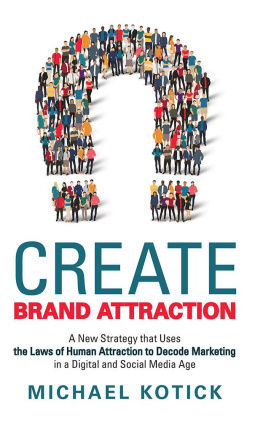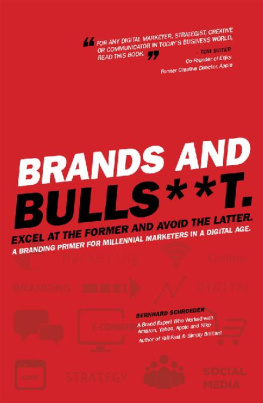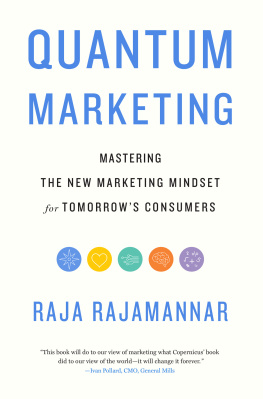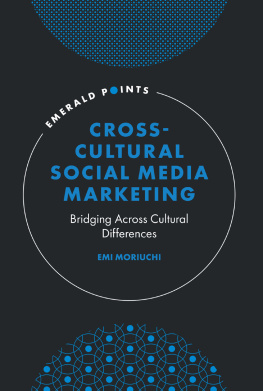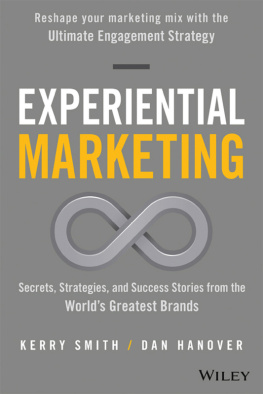Create
Brand Attraction
A New Strategy that Uses
the Laws of Human Attraction to Decode Marketing
in a Digital and Social Media Age
Michael Kotick

Copyright 2017 Monocle LLC.
All rights reserved. No part of this book may be used or reproduced by any means, graphic, electronic, or mechanical, including photocopying, recording, taping or by any information storage retrieval system without the written permission of the author except in the case of brief quotations embodied in critical articles and reviews.
This book is a work of non-fiction. Unless otherwise noted, the author and the publisher make no explicit guarantees as to the accuracy of the information contained in this book and in some cases, names of people and places have been altered to protect their privacy.
Archway Publishing
1663 Liberty Drive
Bloomington, IN 47403
www.archwaypublishing.com
1 (888) 242-5904
Because of the dynamic nature of the Internet, any web addresses or links contained in this book may have changed since publication and may no longer be valid. The views expressed in this work are solely those of the author and do not necessarily reflect the views of the publisher, and the publisher hereby disclaims any responsibility for them.
Any people depicted in stock imagery provided by Thinkstock are models, and such images are being used for illustrative purposes only.
Certain stock imagery Thinkstock.
ISBN: 978-1-4808-4126-0 (sc)
ISBN: 978-1-4808-4127-7 (hc)
ISBN: 978-1-4808-4128-4 (e)
Library of Congress Control Number: 2017902264
Archway Publishing rev. date: 5/10/2017
CONTENTS
To Ron, Nurit, and Brian, who always have the courage to dream big wit h me.
Special thanks to Joe Shepter for a year of great conversation in the development of this book.
Preface
Lost in Translation
When social media first became popular, I was only a few years out of business school. My bosses at the time had come of age in a world of TVs and faxes, and like many, they found the new platforms puzzling. Why were so many people spreading so much information (and misinformation) about their brands? What could they do about it? To figure out the answer, they did what people in our profession often do when theyre stumped by new technology: they found a younger person to explai n it.
One of those people turned out to be me. At first, I wasnt helpful. I had grown up natively with digital technology, and it all made perfect sense to me. I was comfortable with likes and shares and letting the entire world know what I had for breakfast. As a result, my first, jargon -f illed pass at explaining the brave new world was met with blank stares. I needed to explain my explana tion.
I realized that I had to find a way to translate the digital experience into something anyone could understand. I first thought of explaining it with networks, but most people dont have an intuitive grasp of them. Instead, I needed something that everyone would instantly get. Luckily, at the time I was also, as were many people my age, exposed to online dating networks. I was helping friends set up profiles, chat with people they barely knew, and try to get dates. Suddenly, it struck me. Attraction . That would explain what was going on in a way everyone could unders tand.
I marched back to work and laid out the idea. I explained that in the old days, when you were looking for a date, you typically met people first and got to know them later. But in a new digital and social world, we could now go online and find out quite a bit about a person before we ever got in touch. There was even a name for this: Facebook stal king.
The same thing, I said, was happening with brands. Marketers used to be able to reach out to people through TV, but consumers would ultimately have to get their hands on a product to find out whether they liked the brand or not. Now, all that information was exposed. Anyone interested in buying something could go online and find out what our brands and products were like well before purchasing them.
Obviously, this is basic stuff today, but back then, it helped bridge the gap. They nodded their heads. They got it. And we started to talk about it and work through the problem. We could have a strategic conversation that didnt require them to hop on Facebook every day for a year f irst.
I never thought that explanation would be the start of anything; it just seemed like a good analogy at the time. But like many people in the digital bubble, Im often asked about technology, especially by my parents. When my mom wants to know about the Apple Watch or Slack or why people like Tinder, Im the first person she calls. And Ive found that there is a huge gap in how she responds if I answer her in digital -s peak versus attraction -s peak . The former almost always gets a reply along the lines of, But why? If I use the latter approach and speak in the language of attraction, she invariably gets it and understands exactly why someone would want to do the things people are doing on line.
For a simple example, if my mom hears me talking about native ads, I dont try to explain programmatic buying or content marketing. I say that they are brand pickup lines. They are a quick outreach that tries to hook someone into a larger conversation. If my mom asks me why her favorite flour brand has created an online educational site about baking, I might say, Well, youve bought their products, so theyve had a few nice dates with you. Now they want to deepen the commitment. Then she underst ands.
The surprising thing is that this language is remarkably durable for use in describing new developments in marketing overall. By the time youre reading this, some of my examples will probably be a little staleand some of the ones Ive touted as great successes will likely be seen as pass. Nonetheless, youll be able to use the language of attraction to explain whatever is going on. It worked in the infancy of social, it continued to work as new platforms were added, and it now works quite well for instant messaging. Whatever new technology the Musks, Zuckerbergs, and Bezoses dream up, youll likely be able to use dating and relationship analogies to describ e it.
This should not be surprising. We often think of technology as something that has changed our lives. But we forget who made that technology in the first place. Its us. Giraffes are not out there figuring out what mobile devices and social networks should be like. Kangaroos arent pressing like buttons or sharing viral videos. We (and by this I mean ordinary consumers) do this.
Whenever we use technology, we take part in shaping it. We pick the winners among apps. We provide data and information to those who are developing them. If we like a feature, we use it. If we dont, we dontand likely share loud complaints about it in social media. In this way, we all play a vital role in the evolution of techno logy.
Which begs the question: what do we want technology to do? Of course, we want escape, entertainment, and education. But, believe it or not, those are all modest use cases. What we really use it for is to connect with people. We build and maintain relationships. Thats why nine of the top ten mobile apps used globally are either social networks or instant messaging apps (the tenth is a game with social elements to it). We chose Facebook over MySpace not because it had a superior timeline or improved shareability, but because it was better at putting us in touch with others. Today, we are flocking to WhatsApp, WeChat, and Facebook Messenger for much the same re ason.
In fact, this trend is not a new one when it comes to technologyit goes way back. Since the beginning of rapid communications, we have asked it to help us with our offline social lives. In the book The Victorian Internet , for example, Tom Standage devotes an entire chapter to how the telegraph fostered love, not least among those using it every day: telegraph operators. The reason is fascinating. It turns out that telegraph operator was one of the few professions in the 1800s in which women made up a large percentage of the workforce. As soon as operators started sending messages, they began to flirt over the lines. Soon, romance bloomed. Many marriages came as a result (and also a few horrifying first - a nd -l ast encounters on train platforms). Love conquers all, it seems, even in Morse code.
Next page
